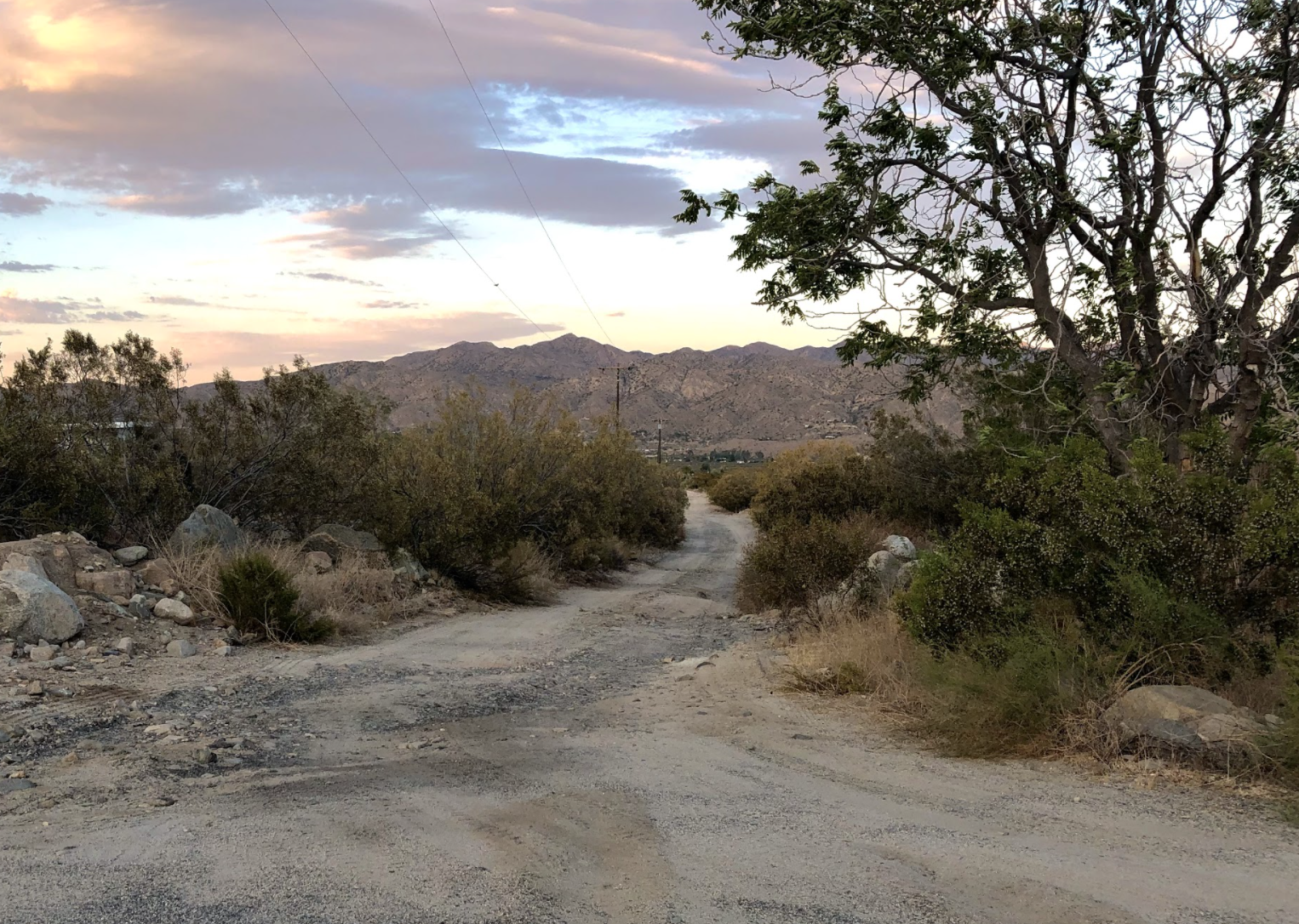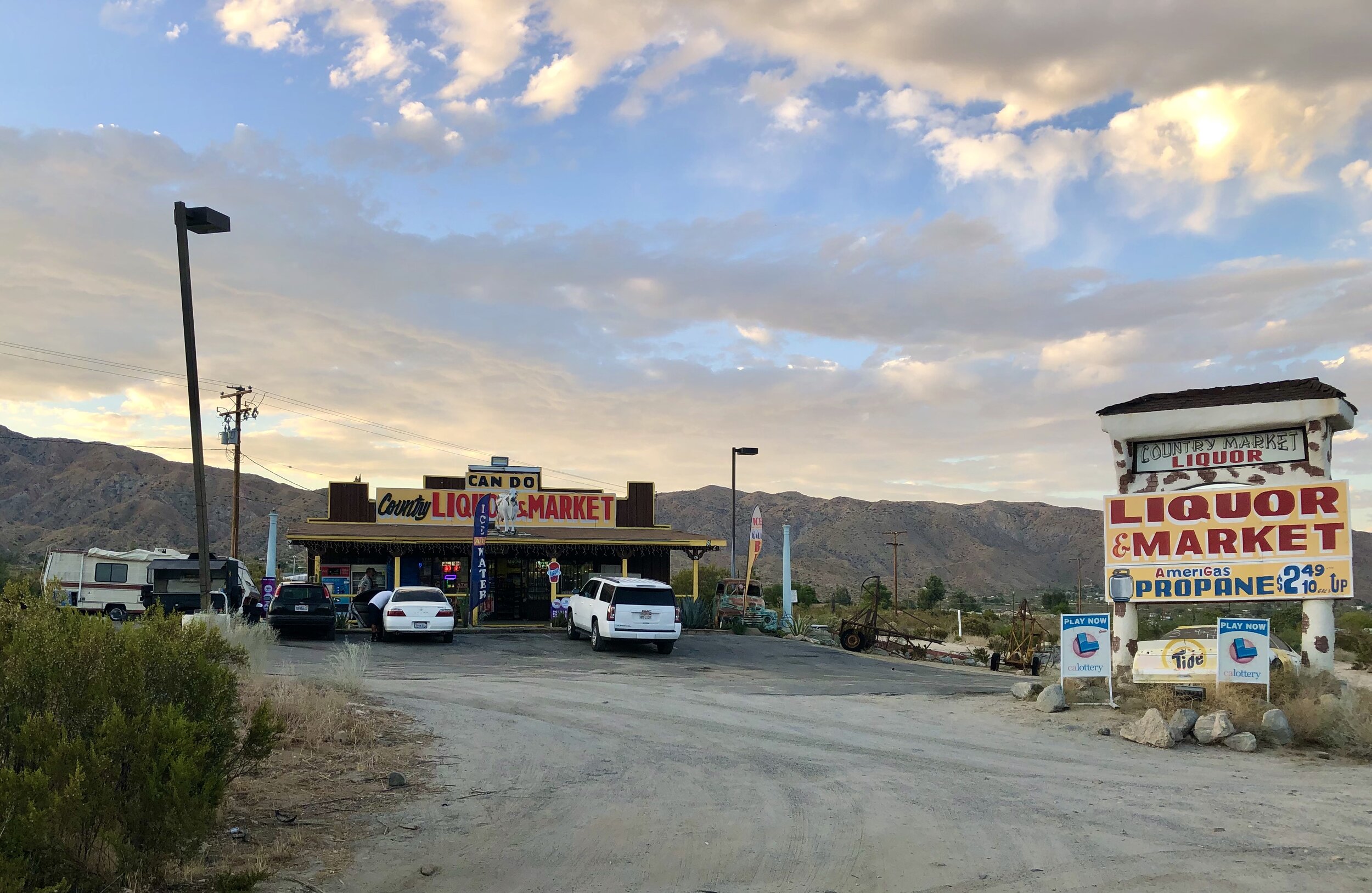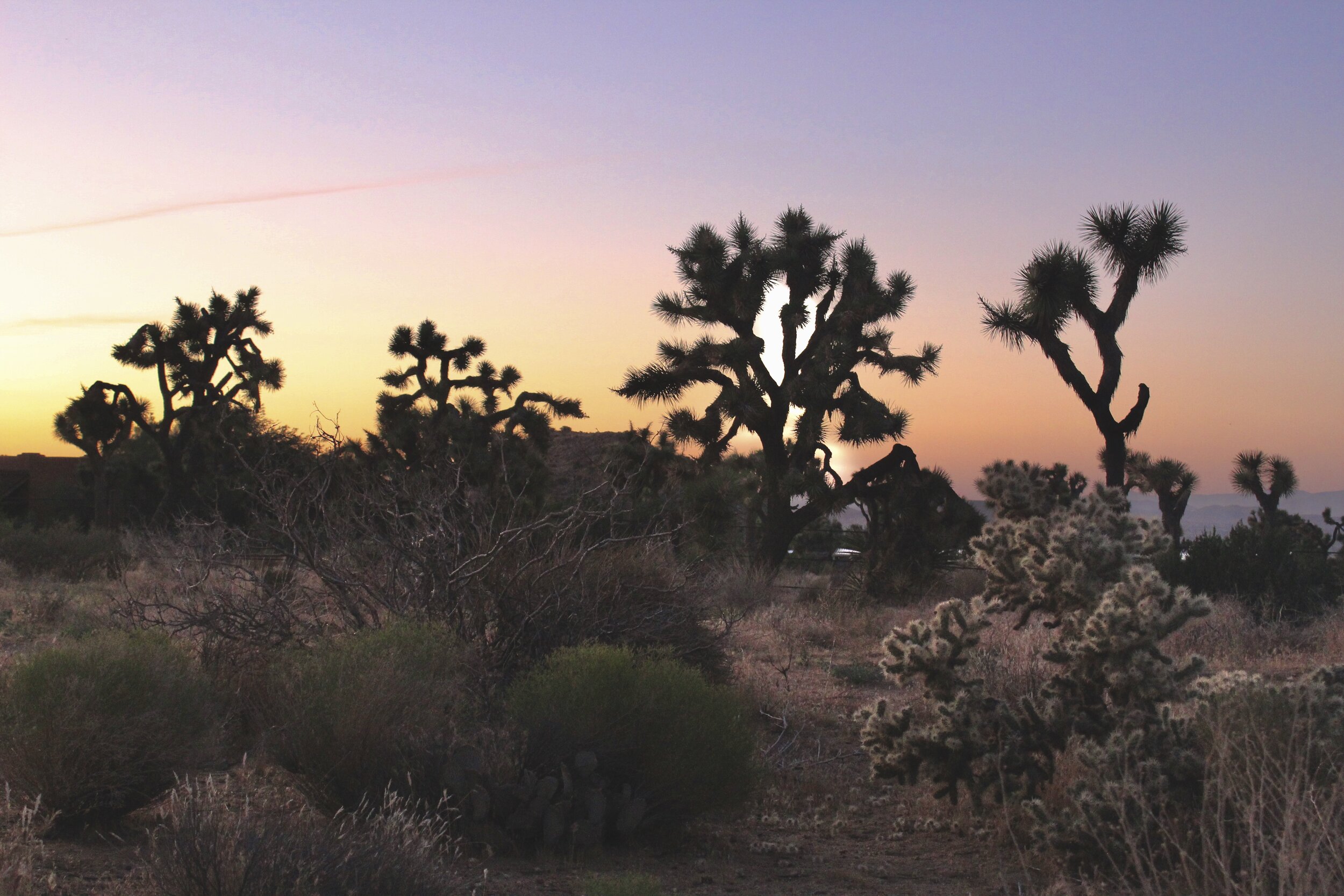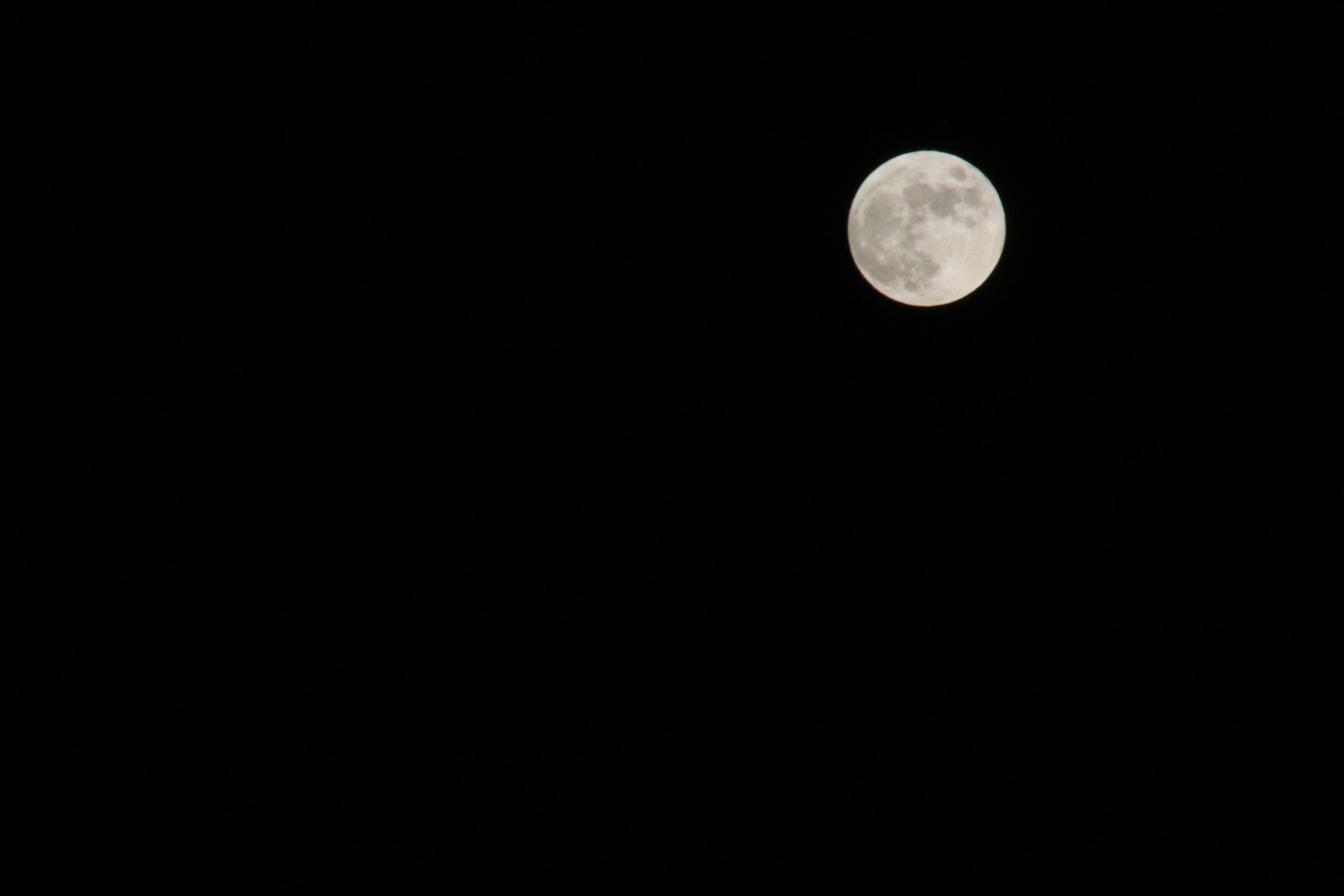5.10 “Every Night, I Stare Upon The Surface Of The Moon”
A Dispatch from the High Desert
CC Perry
with photos by Melissa
Hi Friend,
Here, an assurance: even in panicked, pandemic-y July, the desert remains hot and dry.
I’m outside the Pioneertown Motel, with it’s artfully-knotted lassos and musk-scented soaps, boot-tapping the expanse of ranch sand. Regarding my viral anxieties...let’s not talk about them. Can any Californian gaze at the sun and not see her reflection in it? I could hold up my panic like a prism in this 100-degree heat, regard it’s facets, stab at defining the Before Time and Whatever We’d Call Now.
I could write the fuck out of a glass of orange juice. It doesn’t mean that I should.
The cacti are blooming and as Melissa once said, “There are moments in life where it would be despicable not to be happy.”
Also: “Self-care in service of self-preservation is not self-indulgence.”
And, regarding cottontail rabbits: “They dart in front of your car with a death wish — but as it turns out, girl, you do not need to have an infinite well of empathy.”
***
Here’s Melissa’s 1966 Ford Bronco, jade green, chrome spattered in dust, trundling toward me. When I climb into the carriage, I note her vintage jade jacket to match. Melissa’s smile is lit from the internal fire of being the type of force multiplier who frequently does things of consequence.
A classically beautiful combat veteran with the heart of an activist, she’s taught me that you can cultivate a luminous government career — Marine Corps, Diplomatic Security Service, State Department — and remain true to your forearm tattoos, long-sleeved suits be damned. She’s taught me the art of self-deprecation, humbly owning the authorship of intelligence briefings that routinely ended up on the desk of the President.
And she’s taught me that one can trade a steady work path for a surprise move to Morongo Valley, embracing an authentic, isolated life of being “everyday awed by nature at such scale.”
Pipes Canyon Road
In the Bronco, Melissa teaches me how to mix a Moscow Mule in a bottle of ginger beer.
“The gains in the desert are real,” she says, hunting her seatbelt buckle. “I don’t have to be a Foreign Service Officer for thirty-five years and get the gold watch and the plaque. That’s a fascinating, compelling, and wonderful human experience. But I’ll never have the biopic.”
She slips the opening of her seat buckle under a Fever Tree Ginger Beer cap, provokes the crack, and glugs the bottle down well past the neck. She unscrews a vodka top “so heavy we should probably vandalize something with it.” And then pours the vodka in, followed by her thumb as a seal, tipping the entire affair upside down to fizz to a perfect mix.
“In my career, I felt comfortable saying that I put together a target package, and we raided that compound, and they killed fifteen people, and one of them was a woman who put children in explosive vests and convinced them to blow themselves up,” she says. “Well! Here are the receipts. But, that’s a bunch of bodies as a measure of success. I’ve left that behind.”
I think of the other “essentials” that Melissa has willfully left. Roads, as her neighbors must form a special committee should they choose to pave one. Schools, with her 11-year-old son remote from the living room. Postmates and the Postal Service, as she daily fetches her mail from a line of boxes at the hill-bottom of her street. And though she did not experience the shutter of her major shopping center, the roadside Morongo liquor mart (with its giant plaster cow on the roof) became “so spartan it put everything in stark relief.”
Swing/Sun/Set

Mailboxes at the Bottom of the Hill
 The Final Mile Home
The Final Mile Home
With regards to the grinding-of-a-halt of the relentlessly chugging machine of late capitalism, I tell her: of late, I am essentially disposable.
She takes a long pull of her drink. “I want you to look at some rocks. The rocks are the thing.”

***
We take the Bronco down a long road, motoring from gnarly tree to shrub, past cocky little cacti needling themselves toward the sky.
To understand life in Morongo is to know what it is not. It’s not Coachella, fancifully farming both dates and wind, or Palm Springs, with its palm trees and pristine poolscapes. It’s not Desert Hot Springs, all meth labs and bubbling minerals, or the Yucca Valley, with its Joshua Tree idolatry and artists seeking crystals and collaborations. It isn’t Indio, with its Instagram of influencers.

Joshua Tree Idolatry

Open House
It’s only the hill — only the climb — from the San Bernardino County Line. Where twelve hundred people shelter in rammed earth homesteads and horse farms, and the Mojave Desert ends in a dramatically-carved canyon wash. On the NextDoor app, neighbors discuss rattlesnakes, losing chickens, bears tipping over garbage cans, and ground squirrels nesting under the hoods of their trucks. The coyotes work themselves up between ten and eleven at night, doing their Coyote Business. Sitting on Melissa’s back patio, perched far up the mountainside, no road noise will reach you — though you can see the distant lights from cars winding down highway sixty-two.
She “never tires of the view. Of seeing them down there. Going wherever it is they’re going.”

Here, an arrival: at the rocks, prehistoric and precariously scrambled, piles and piles on the mountainside.
After parking in a ditch, Melissa descends from the Bronco, wind playing with the hem of her marigold dress. She stands in the shadow of a tumbling, bawdy, knock-toothed, rubble of boulders that’s inspired centuries of mediocre haiku. Somewhere, someone has the bandwidth to tackle a poem about ancient granite, and sentinels, and stoic virtues of justice and perseverance and fortitude.
I need the silence the rocks provide.

Notebook, Pipes Canyon

Pioneertown Rock Tower
“If this one rock formation were back in DC, it would be the city’s centerpiece,” Melissa offers. “This would be the skyline on every t-shirt. But out here? These rocks are just one of many spectacular things that isolation affords.”
She sinks down to the dirt.
“Last night, I watched the moon rise. I stepped outside to close the garage door, and I could see the glow of the moon behind the mountains. I was fully captivated by how quickly the moon came up. Every night, I stare upon the surface of the moon.”

Moon over Morongo

Once, This Was the Seafloor. Pioneertown Rock Pile.
I settle on the dirt of a rock of my own. Seven million years ago, this desert basin was the seafloor. These rocks have seen the bottom of the ocean, and a pandemic or two, before.
My audio recorder catches 11 minutes and 24 seconds of pure silence. Melissa and I, Alone Together, as the sun sets.
Here, an admission: I can’t wait to watch how quickly the moon will rise.
In Happiness,
CC
I settle on the dirt of a rock of my own. Seven million years ago, this desert basin was the seafloor. These rocks have seen the bottom of the ocean, and a pandemic or two, before.
My audio recorder catches 11 minutes and 24 seconds of pure silence. Melissa and I, Alone Together, as the sun sets.
Here, an admission: I can’t wait to watch how quickly the moon will rise.
In Happiness,
CC


Pet Rocks